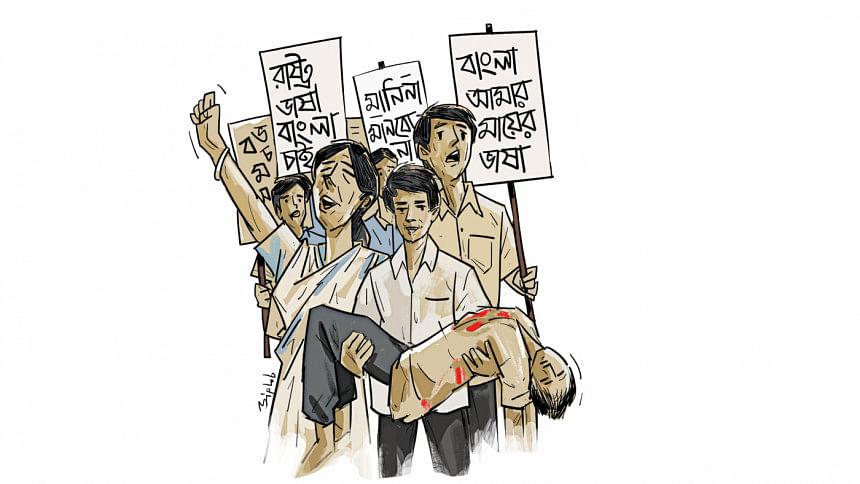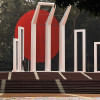The first Shaheed Minar

This year marks the 73rd anniversary of the 1952 Language Movement. Drawing on research based on various published books, this 21-part series tells the story of the historic struggle for our mother tongue.
February 21, 1952. Rajshahi. The day had been a whirlwind of strikes, protests, and meetings.
In the evening, the news of the worst arrived from Dhaka, and everything changed.
The air crackled with sombre energy, a heavy cloak of grief draped over the city.
Amidst the despair, a flicker of defiance emerged.
As night fell, a group of students gathered on Rajshahi College grounds next to the New Hostel. Their hearts heavy, but their spirits unbroken.
Illuminating the dark with lanterns and torches, everyone joined hands in shaping bricks and clay into a memorial dedicated to the fallen heroes.
As the first Shaheed Minar rose from the ground, the monument was embellished by verses from Tagore's "Suprabhat," an ode to the courage and sacrifice of those who dared to dream:
"Whose words do I hear on the way to dawn,
There is no fear, he has no fear.
He who gives his life to the uttermost,
There is no decay, he has no decay."
Earlier in the day, young men in Dhaka had sacrificed their lives to have Bangla, their mother tongue, recognised as an official language.
Despite the authority's imposition of Section 144 (a ban on public gatherings), students took out a march from Dhaka University to protest the government's decision to declare Urdu as the only official state language of East Pakistan, ignoring Bangla despite it being the lingua franca.
When the students attempted to march towards the Secretariat building, police opened fire, killing several students, including Salam, Barkat, Rafiq, Shafiq, and Jabbar.

CITY OF RESISTANCE
Students in Rajshahi first joined the fight to recognise their mother language in February 1948, when Dhirendranath Dutta put forth a proposal to make Bangla an official state language in the Constituent Assembly of Pakistan and it was rejected.
Rajshahi College and Bhuban Mohan Park became the epicentres of these early movements.
According to the book, "Rajshahi te Bhasha Andolon" by Dr Tasikul Islam Raja, a hartal in response to the call for a nationwide strike by the central unit of Rashtrabhasha Sangram Parishad, paralysed the city on March 11, 1948.
A protest rally, held at Bhuban Mohan Park, reverberated with the iconic slogan, "Rashtrabhasha Bangla Chai!" (We want Bangla as a state language!)
However, the peaceful demonstration was met with brutal force as police opened fire on a student procession marching towards the Barendra Museum, injuring many.
The 1948 movement saw the emergence of student leaders like Mohammad Sultan and Ekramul Haq, who, inspired by the guidance of esteemed professors like Abdul Hai, Dr Muhammad Enamul Haque, and Golam Maksud Hilali, spearheaded the resistance, writes Dr Tasikul in his book.
As the zeal of the Language Movement intensified in 1952, Rajshahi once again emerged as a city of resistance.
As per Ahmed Rafiq's book "Bhasha Andolon: Teknaf to Tetulia", in February 1952, following the formation of the All-Party State Language Action Committee in Dhaka, a similar committee was formed in Rajshahi, with SMA Gaffar, a student of Rajshahi Medical School (later Rajshahi Medical College), as its president and Golam Arif Tipu, a senior student of Rajshahi College, as its general secretary.
On February 4, Flag Day, a symbolic gesture of solidarity, was observed, in line with the national call.
On February 21, a public meeting held in the afternoon at Bhuban Mohan Park was disrupted by the news of the student killings in Dhaka.
According to the book "Rajshahi te Bhasha Andolon", grief and anger fuelled the students, who erupted in protest, chanting slogans like "We will not let the blood of the martyrs go in vain. We want Bangla as the state language!"
Later that evening, hundreds of students gathered at the Rajshahi College grounds.
We also learn from Dr Tasikul's book that the country's first Shaheed Minar, a symbol of resilience and remembrance, was constructed that very night.
Student leaders like Golam Arif Tipu, Sayeed Uddin Ahmed, SMA Gaffar, Anwarul Azim, and many others were part of this collective effort.
The memorial, which they had named the "Shaheed Smriti Stambha" (Martyrs' Monument), was unfortunately was short-lived and fell victim to the brutality of the authorities.
On February 22, when students were busy plastering the city with posters and engaging in peaceful protests, the police arrived at Rajshahi College grounds and demolished the memorial.
While the Shaheed Minar in Dhaka, designed by renowned architect Sayeed Haider, would later become a national symbol, it was in Rajshahi, on the night of February 21, that the first tribute to the martyrs of the Language Movement took shape.
Translated and edited by Subrata Roy.

 For all latest news, follow The Daily Star's Google News channel.
For all latest news, follow The Daily Star's Google News channel. 







Comments